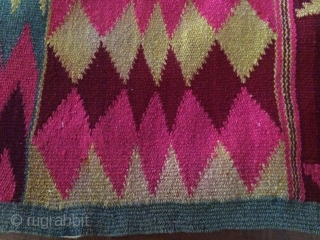Highland Project The Huamachuco Textile Project was an effort by a group of experts in anthropology, history, symmetry, and other disciplines brought together to understand the blankets’ history as well as analyzing other textiles collected over a period of thirty years (1977-2006). Although blankets have been woven in the Peruvian highlands for thousands of years, this tradition evolved over the last 100 years or so. Striped blankets used by the indigenous population around Huamachuco were woven on pre-Hispanic back-strap (callua) looms while banded and checkerboard patterned blankets were woven on treadle looms introduced during colonial times when obrajes (textile manufacturing centers) were established, particularly on large haciendas. In the obrajes Merino sheep, introduced by the Spanish, provided the dominant fiber used to manufacture textiles. Large herds of sheep soon replaced the native camelids of pre-Hispanic times, especially in the region around Huamachuco.
History of a Royal Belt The ancient lands around the Tulpo hacienda make up the blanket area. Since the time of the Inca Huayna Capac to around 1572, these lands were used as royal pastures (soto reales) for the camelids whose fleece was used to weave cumbi, mostly tapestry woven textiles for the Inca and Huamachuco nobility. There was another type of cumbi, however, that was also woven for the nobility during Inca times and used in belts. During one of her trips into the blanket area, Dr. Lynn Meisch, an Andeanologist, weaving expert and anthropologist at St. Mary’s College in Moraga, California, observed that i was using a hand-woven belt to strap my sleeping bag. i had used the same belt for more than twenty-five years, not only because it was very beautiful but also because it was very different from most of the belts woven in the region.
Dr. Meisch had learned about the belts from a paper presented by Sophie Desrosiers at the Junius b. Bird Conference on Andean Textiles in 1984. Desrosiers had decrypted and interpreted coded information taken from the last page in the previously lost original (Galvin) Murúa chronicle written around the end of the 16th century. The document was a technical description on how to weave a belt used only by the coya (Inca queens and princesses) during important festivities and events. Desrosiers wove two examples of the belt but concluded that the technical description encoded by Murúa was wrong and that it was probably impossible to weave the belt described in four colors. However, the belt around my sleeping bag looked similar to the one woven by Desrosiers and described by Murúa in four colors.
Read the full article at Rumbos del Peru
Text: Joseph Fabish y Horacio Rodríguez Photos: Joseph Fabish, Amadeo y Segundo Pérez
- Home
- Antique Rugs by Region
- Category
- Profiles
- Post Items Free
- Albums
- Benaki Museum of Islamic Art
- Budapest: Ottoman Carpets
- Gulbenkian Museum
- Islamic Carpets. Brooklyn
- Islamic Textiles. Brooklyn
- Konya Museum: Rugs
- MKG, Hamburg
- MMA: Caucasian Carpets
- MMA: Mamluk Carpets
- MMA: Mughal Indian Carpets
- MMA: Ottoman Carpets
- MMA: Safavid Persian Carpets
- MMA: Turkmen Rugs
- McCoy Jones Kilims
- Ottoman textiles. Met
- Philadelphia Museum
- Rugs and Carpets: Berlin
- Seljuqs at the Met
- TIEM, Istanbul: Carpets
- V&A: Classical Carpets
- Vakiflar Carpets: Istanbul
- Baluch Rugs: Indianapolis
- Gallery Exhibitions
- Jaf an Exhibition
- Alberto Levi Gallery
- Andean Textile
- Christie's London: 2016
- Francesca Galloway
- HALI at 40
- ICOC Washington, DC 2018
- Jajims of the Shahsavan
- London Islamic Week April, 2018
- Mongolian Felts
- Navajo Rugs: JB Moore
- Persian Piled Weavings
- SF Tribal & Textile Art Show 2020
- SF Tribal 2019
- Sotheby's: C. Alexander
- Turkish Prayer Rugs
- Turkmen Main Carpets ICOC 2007












